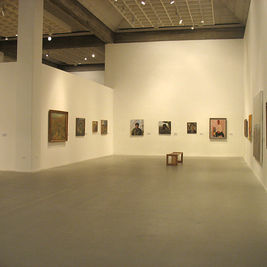New Acquisitions, Tel Aviv Museum of art, 2007 Curator: Ellen Ginton Ilan bauch from the Collection of the Tel Aviv Museum of Art 1. Halil in the Shade of a Sabra, 2006, 67 x 64 cm. 2. Cypress Tree in Jerusalem, View from the South, 2006–2007, 120 x 100 cm. The paintings of Ilan Baruch reflect an ongoing exercise in the language and methods of figurative painting. His meticulous exploration of the expression of the pictorial values of climate, light, texture, and material is indicative of a particular interest in the significance of the object and its mythic and symbolic value, and the study of the place, its spirit and manifestations. The actual labor of painting takes place outdoors, without the mediation of a camera and without any further processing of the canvas when it is back in the studio. In this manner, Baruch has devoted dozens of paintings to depictions of the Jerusalem landscape, its sabra plants and cypress trees, and shepherds grazing their flocks in pastures near the villages of Ein Kerem and Kfar Ruth. Baruch bases his investigations on the creation of large-scale thematic series that focus on a central object utilizing various formats and focal points. Sometimes it is the foliage of a cypress tree that covers an entire canvas, its trunk and branches an incidental part of an all-encompassing panoramic landscape. Ilan Baruch started to paint at the age of 14. His father was the one who urged him to look at landscape, to paint, and thus, to recognize his true calling as a painter. For the son of a religious family of Bukharian origin that settled in Jerusalem in the 1930s, there was no more foreign or strange occupation than painting. Despite the hesitations of his extended family, it was his father who encouraged his son to leave his studies and his friends and devote himself completely and uncompromisingly to the practice of his art. His father even brought him to the doorstep of the art school near their home in the Geula neighborhood of Jerusalem, which had been established by Rabbi Adin Steinsaltz to enable members of the religious community to study fine art. Baruch studied there for a short time, during which he formed a bond with the artist Liliane Klapisch who taught there. This was the first and only formal art training Baruch received. Later he studied philosophy at the Hebrew University of Jerusalem. His subjects are loaded from the beginning with a familiar mythic charge that derives from the repertoire of images representative of local culture: the cypress tree, the Arab, the sabra, and the shepherd, which were interpreted variously in the local context. For example, over time the sabra changed from being a founding symbol of Zionist nationalism and local culture to a symbol of the shattering of that ethos and a sobering moment of awakening. Baruch’s paintings challenge the validity of the definition of the mythic status of the painted object by portraying it simultaneously from the vantage point of unique and specific investigation and inclusive mythic context. The subject that is depicted is constantly changing its status from an image and a type to a portrait with unique features and a name, and back again to a comprehensive, inclusive image. His work investigates and raises anew the question of place and its conception, by unraveling the definition of the boundaries of the mythic elements contained in it, their dismantling, and rebuilding. For example, Baruch chose to challenge the cultural baggage attached to the concept of the sabra in a series of paintings that focused on the thorny plant that is, in fact, indigenous to Mexico. Baruch insisted on calling the plant “cactus,” thereby linking it once again to its seemingly “objective” botanic nature. Defining that very elusive movement amidst the vastness of the object’s layered identity [that vacillates] between metaphoric image and physical element has formed a major part of Baruch’s work over the years. Once, while working, Baruch chanced to meet Halil, a Bedouin shepherd of the Azazma tribe from the village of Hirbet. Halil’s curious gaze at a painting of a tree in a landscape sparked a connection, which lead to the creation of a series of portraits. Gradually a friendship developed that defied the barriers of language and culture. Their meetings extended beyond the chance encounter in the field and they discovered they had much in common. Ironically, a portrait of Halil that embodies the notion of connection and attachment depicts him next to the separation fence in the area between the Palestinian villages west of Ramallah and the hills nearby the Israeli city of Modi’in. In addition to trying to capture Halil’s outward features as well as his inner nature, in his portrait Baruch also grapples with the representation of the Arab, the Middle Eastern male, the ultimate “other,” as he has been perceived for years in local art and culture. Halil, in classic pose, is depicted in harmony with the landscape that surrounds him. His convex form aligns perfectly with the outlines of the stone he leans against. A clear, direct parallel is created between the sabra and the figure that lies on the ground next to it. Behind Halil are a Bedouin tent and the Old City of Jerusalem, complementary opposites that are expressions of the temporary and the eternal, the material and the spiritual in his world. Halil’s level gaze outward at the artist, at the viewer, confirms the reality of his permanent, stable, physical presence in this space. He stares easily at the viewer as he leisurely leans back and smokes a cigarette. These gestures and actions embody as well stereotypical notions of the Mediterranean male. Despite the long-standing burden of all these preconceptions, does the power of a thoughtful portrait have the ability to propose an alternative dialogue?
"New Acquisitions" Tel Avivi museum of art
Tel Aviv 2007















